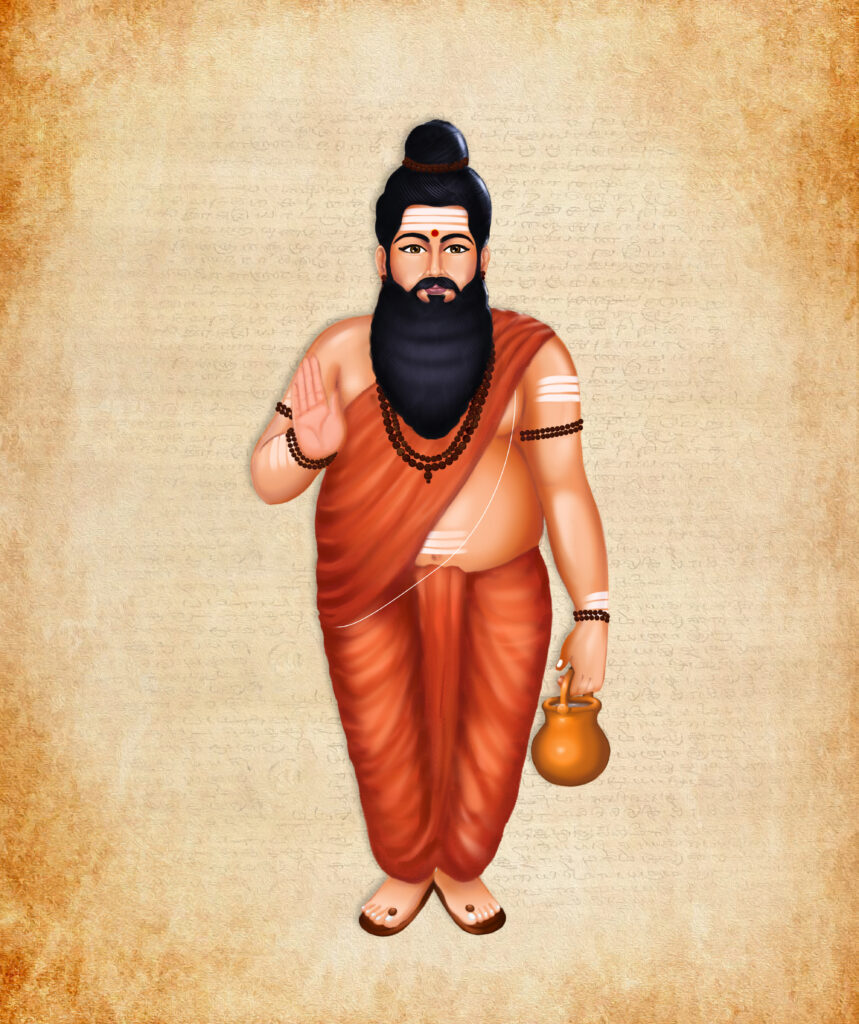
The palm leaf manuscripts and their Nadi astrology predictions were written by siddhas (beings with paranormal capacities), maharishis (great seers) and scholars. We know that scholars are specialists in a particular field of study or academics, but how can we comprehend these siddhas or rishis?
Siddhas are individuals who have and use super spiritual powers. Apparently, the siddhas received their super spiritual powers from the Almighty. Supposedly, through various different yogic practices – they are superhumans with divine blessings. Some even consider them to be immortal because of their powerful astral presence.
Among the many siddhas and rishis known throughout Indian/oriental history, there were 7 rishis during the Vedic period in India (c. 1500 – c. 500 BCE) which many consider to be the most powerful and renowned of all.

Maybe Maharishi Agastya looked like this?
The term saptarishi means seven rishis (sages or seers). However, as common to this period in Indian history, the list of exactly which seven rishis actually constitute the saptarishi varies from region to region, text to text, time period to time period.
Actually, the Vedic literature that refers to the saptarishi never lists them by name. Lists of their names only begin to appear in later texts.
The text Jaiminiya Brahmana in its verses 2.218–221 lists the saptarishi as: Agastya, Atri, Bhardwaja, Gautam, Jamadagni, Vashistha and Vishvamitra.
A slightly different list appears in Brihadaranyaka Upanishad: Atri, Bharadwaja, Gautama, Jamadagni, Kashyapa, Vashistha and Vishwamitra.
Gopatha Brahmana however, names Vashistha, Vishvamitra, Jamadagni, Gautama, Bharadvaja, Gungu, Agastya and Kashyapa as the seven rishis.
Further, to confuse matters even more it was not uncommon in those days for a single spiritual figure or master to be known by different names depending on the region.

Although there were many, history has evidence of 18 important siddhas who contributed enormous amounts of knowledge to the world.
In addition to mystical knowledge, Tantric practices, and wisdom, all the siddhas also excelled in medicine and astrology.
Also, there exist traditions within the streams of both Indian and Tibetan Tantric practice that consider 84 mahasiddhas although again the list tends to vary from tradition to tradition.
(Check out our very first published book “Divine Masters of India: The 18 Siddhas and Their Timeless Teachings“)
Siddhas had the ability to look to both the past and future and were able to go to the past through their meditation for some important tasks. Consequently, the siddhas foresaw the future and, out of love, used this capacity to write important life details of many many human beings on what we now know as the nadi leaves.
Lord Shiva asked Sage Agasthiyar to write about the future of people who would live during Kali Yuga (Kali Yuga is the present period in time where all sorts of negativity prevail in the world). Most importantly, he understood that the people whose lives were written about in those leaves would eventually come looking to them for guidance. Stephan discusses the blessing of the rishis in the short Youtube Video above.
Agasthiyar and other siddhas foresaw the lives of people and wrote this information on palm leaves, writing 14 chapters for each person.
The Siddhas had excellent knowledge of foreseeing and astrology, and they used both of these fields of knowledge to write palm leaves for millions of people. Therefore, the siddhas guide us until today and hold our hands on the way to salvation.
The chapters of each person’s palm leaf are:
All of these chapters are combined into a bundle, with each bundle holding information about each person. Subsequently, reference leaves contain summaries of each bundle and are stored within an index bundle. This is similar to modern libraries where they have index books to find specific books arranged on the shelves. To understand better how this process works, check out our How It Works page.

The followers of the siddhas preserved the leaves using various methods. In addition, temple libraries safely stored palm leaves in India, although insects and natural disasters are a pervasive problem. These days, libraries preserve palm leaves with the latest methods to ensure they will continue on to the next generations.
In conclusion, the palm leaves are treasures given to the 21st-century people by the siddhas, especially Sri Agastya Maharishi, with the blessings of all Gods. Therefore, let us all approach the rishi’s treasure in a positive way so that we too can receive these divine blessings.
Finally, you may seek the blessing of these masters and begin the search for your ancient Indian palm leaf prophecy.
published: 02/09/2021